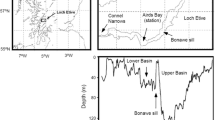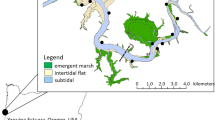Abstract
Intertidal sediments experience substantial changes in temperature, salinity, and solar irradiation over short time periods. We applied the Fluorescently Labeled Embedded Core (FLEC) technique to map distribution patterns of microbenthos in tidal creek sediments. Our aims were to determine if micro-scale distributions varied over the course of a day and to test the null hypothesis that microbenthos are randomly distributed. Eight samples were collected at 3 h intervals from an intertidal sandflat on Sapelo Island, Georgia, USA. Cores were incubated with CellTracker Green (CMFDA, hereafter, CTG), a fluorogenic compounds that accumulates in metabolically active cells. Cores were embedded with epoxy and examined with laser scanning confocal microscopy. Image analysis was used to map the vertical locations of active microbenthos, which in these sediments consisted of benthic microalgae (BMA), ciliates, and flagellates. Microbenthos were abundant over the entire depth profiled (2 cm), although O2 microelectrode profiles indicate that only the top 3 mm of sediment was oxygenated during high light (1,000 μE m−2 s−1). More than 91% of organisms mapped were <22 μm in diameter and, based upon size and cell appearance, were BMA. Microbenthos accumulated in the top 1 mm at 0800 and 1100 h, corresponding to both low tide and high solar irradiation. This pattern conforms to BMA migratory rhythms determined by other methods. The standardized Morisita’s Index of dispersion determined that CTG-positive objects were significantly clumped at all time points and at each of the three spatial scales examined. This clumping pattern likely results from the heterogeneous distribution of resources, such as prey items for phagotrophs and dissolved nutrients or growth substrates for autotrophs or heterotrophs.







Similar content being viewed by others
References
Bernhard, J. M., P. T. Visscher & S. S. Bowser, 2003. Submillimeter life positions of bacteria, protists, and metazoans in laminated sediments of the Santa Barbara Basin. Limnology and Oceanography 48: 813–828.
Blanchard, G. F., 1990. Overlapping microscale dispersion patters of meiofauna and microphytobenthos. Marine Ecology Progress Series 68: 101–111.
Boetius, A., K. Ravenschlag, C. J. Schubert, D. Rickert, F. Widdel, A. Gieseke, R. Amann, B. B. Jørgensen, U. Witte & O. Pfannkuche, 2000. A marine microbial consortium apparently mediating anaerobic oxidation of methane. Nature 407: 623–626.
Böttcher, M. E., B. Hespenheide, E. Llobet-Brossa, C. Beardsley, O. Larsen, A. Schramm, G. Wieland, G. Böttcher, U. G. Berninger & R. Amann, 2000. The biogeochemistry, stable isotope geochemistry, and microbial community structure of a temperate intertidal mudflat: an integrated study. Continental Shelf Research 20: 1749–1769.
Consalvey, M., D. M. Paterson & G. J. C. Underwood, 2004. The ups and downs of life in a benthic biofilm: migration of benthic diatoms. Diatom Research 19: 181–202.
Dixon, P., 1988. Correction. Ecology 69: 1307.
Dixon, P. M., J. Weiner, T. Mitchellolds & R. Woodley, 1987. Bootstrapping the Gini coefficient of inequality. Ecology 68: 1548–1551.
Fenchel, T. & B. O. Jansson, 1966. On the vertical distribution of the microfauna in the sediments of a brackish-water beach. Ophelia 3: 161–177.
First, M. R. & J. T. Hollibaugh, 2008. Protistan bacterivory and benthic microbial biomass in an intertidal creek mudflat. Marine Ecology Progress Series 361: 59–68.
Glud, R. N. & T. Fenchel, 1999. The importance of ciliates for interstitial solute transport in benthic communities. Marine Ecology Progress Series 186: 87–93.
Goni-Urriza, M., X. de Montaudouin, R. Guyoneaud, G. Bachelet & R. de Wit, 1999. Effect of macrofaunal bioturbation on bacterial distribution in marine sandy sediments, with special reference to sulphur-oxidising bacteria. Journal of Sea Research 41: 269–279.
Gücker, B. & H. Fischer, 2003. Flagellate and ciliate distribution in sediments of a lowland river: relationships with environmental gradients and bacteria. Aquatic Microbial Ecology 31: 67–76.
Heffner, R. A., M. J. Butler & C. K. Reilly, 1996. Pseudoreplication revisited. Ecology 77: 2558–2562.
Jesus, B., V. Brotas, M. Marani & D. M. Paterson, 2005. Spatial dynamics of microphytobenthos determined by PAM fluorescence. Estuarine, Coastal and Shelf Science 65: 30–42.
Kelly, J. A., C. Honeywill & D. M. Paterson, 2001. Microscale analysis of chlorophyll-a in cohesive, intertidal sediments: the implications of microphytobenthos distribution. Journal of Marine Biological Association of the United Kingdom 81: 151–162.
Kingston, M. B., 2002. Effect of subsurface nutrient supplies on the vertical migration of Euglena proxima (Euglenophyta). Journal of Phycology 38: 872–880.
Krebs, C. J., 1989. Ecological Methodology. Harper & Row, New York.
Kühl, M., C. Lassen & B. B. Jorgensen, 1994. Light penetration and light intensity in sandy marine sediments measured with irradiance and scalar irradiance fiber-optic microprobes. Marine Ecology Progress Series 105: 139–148.
MacIntyre, H. L. & J. J. Cullen, 1995. Fine-scale vertical resolution of photosynthetic parameters in a shallow-water benthos. Marine Ecology Progress Series 122: 227–237.
MacIntyre, H. L., R. J. Geider & D. C. Miller, 1996. Microphytobenthos: the ecological role of the “secret garden” of unvegetated, shallow-water marine habitats. 1. Distribution, abundance and primary production. Estuaries 19: 186–201.
Miller, D. C., R. J. Geider & H. L. MacIntyre, 1996. Microphytobenthos: the ecological role of the “secret garden” of unvegetated, shallow-water marine habitats. 2. Role in sediment stability and shallow-water food webs. Estuaries 19: 202–212.
Nunan, N., I. Young, J. Crawford & K. Ritz, 2007. Bacterial interactions at the microscale – linking habitat to function in soil. In Franklin, R. B. & A. L. Mills (eds), The Spatial Distribution of Microbes in the Environment. Springer, Netherlands, Dordrecht: 61–85.
Pike, J., J. M. Bernhard, S. G. Moreton & I. B. Butler, 2001. Microbioirrigation of marine sediments in dysoxic environments: implications for early sediment fabric formation and diagenetic processes. Geology 29: 923–926.
Pinckney, J. & R. G. Zingmark, 1993. Biomass and production of benthic microalgal communities in estuarine habitats. Estuaries 16: 887–897.
Reed, A. J., R. A. Lutz & C. Vetriani, 2006. Vertical distribution and diversity of bacteria and archaea in sulfide and methane-rich cold seep sediments located at the base of the Florida escarpment. Extremophiles 10: 199–211.
Revsbech, N. P. & B. B. Jørgensen, 1983. Photosynthesis of benthic microflora measured with high spatial resolution by the oxygen microprofile method: capabilities and limitations of the method. Limnology and Oceanography 28: 749–756.
Rusch, A., S. Forster & M. Huettel, 2001. Bacteria, diatoms and detritus in an intertidal sandflat subject to advective transport across the water–sediment interface. Biogeochemistry 55: 1–27.
Saburova, M. A., A. I. Azovskii & I. G. Polikarpov, 2004. A comparative analysis of the vertical migrations of interstitial ciliates in different types of sediments. Oceanology 44: 535–547.
Sandulli, R. & J. L. Pinckney, 1999. Patch sizes and spatial patterns of meiobenthic copepods and benthic microalgae in sandy sediments: a microscale approach. Journal of Sea Research 41: 179–187.
Stal, L. J., 2001. Coastal microbial mats: the physiology of a small-scale ecosystem. South African Journal of Botany 67: 399–410.
Thoresen, M., 2004. Temporal and Spatial Variation in Seston Available to Oysters and the Contribution of Benthic Diatoms to Their Diet in the Duplin River, Georgia. University of Georgia, Athens.
Acknowledgments
This study was supported by NSF Georgia Coastal Ecosystems LTER grant (OCE-9982133). J. Bernhard critically reviewed an earlier draft of this manuscript. S. Joye was generous with the use of her microelectrode probes and provided guidance for this study. We are grateful for the hospitality and logistical support of J. Garbisch and M. Price at the University of Georgia Marine Institute (UGAMI). J. Bernhard, M. Farmer, S. Joye and C. Meile provided guidance on the design of this project. D. Di Iorio and P. McKay (Dept. Marine Sci., UGA) assisted with the CTD. C. Fleisher (Geology Dept., UGA) advised and assisted on the diamond saw operation. C. Keith and J. Shields (Center for Ultrastructural Research, UGA) assisted with confocal microscope operation. M.R.F. was supported by a UGA Graduate School Assistantship. This is contribution no. 957 from UGAMI.
Author information
Authors and Affiliations
Corresponding author
Additional information
Handling editor: Stuart Jenkins
Rights and permissions
About this article
Cite this article
First, M.R., Hollibaugh, J.T. Diel depth distributions of microbenthos in tidal creek sediments: high resolution mapping in fluorescently labeled embedded cores. Hydrobiologia 655, 149–158 (2010). https://doi.org/10.1007/s10750-010-0417-2
Received:
Revised:
Accepted:
Published:
Issue Date:
DOI: https://doi.org/10.1007/s10750-010-0417-2




